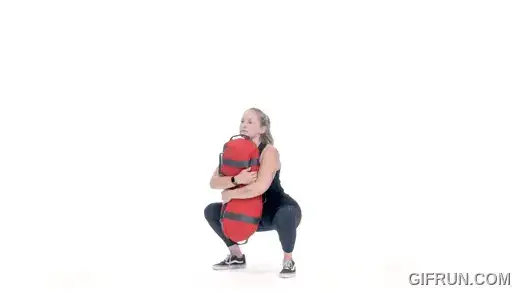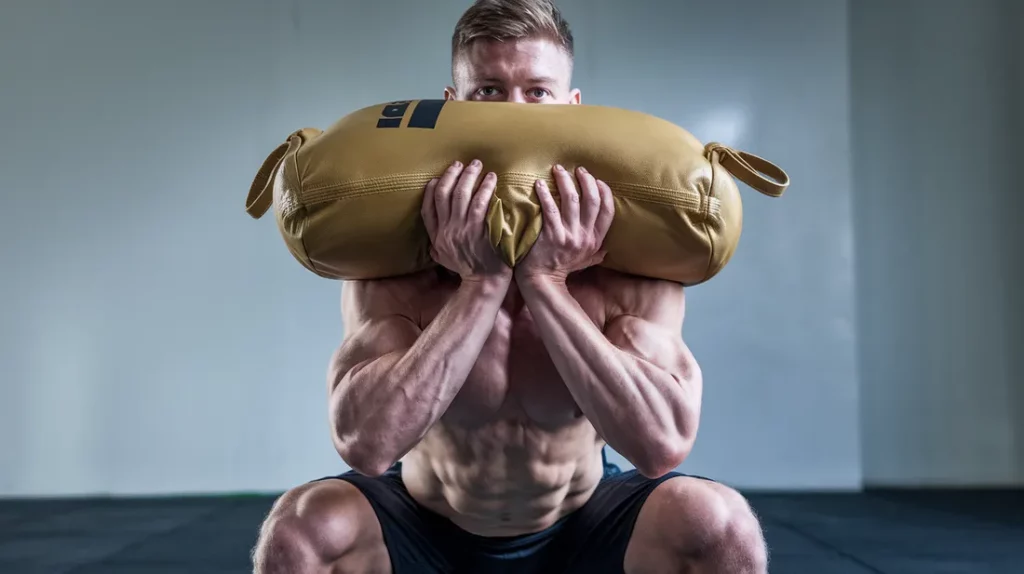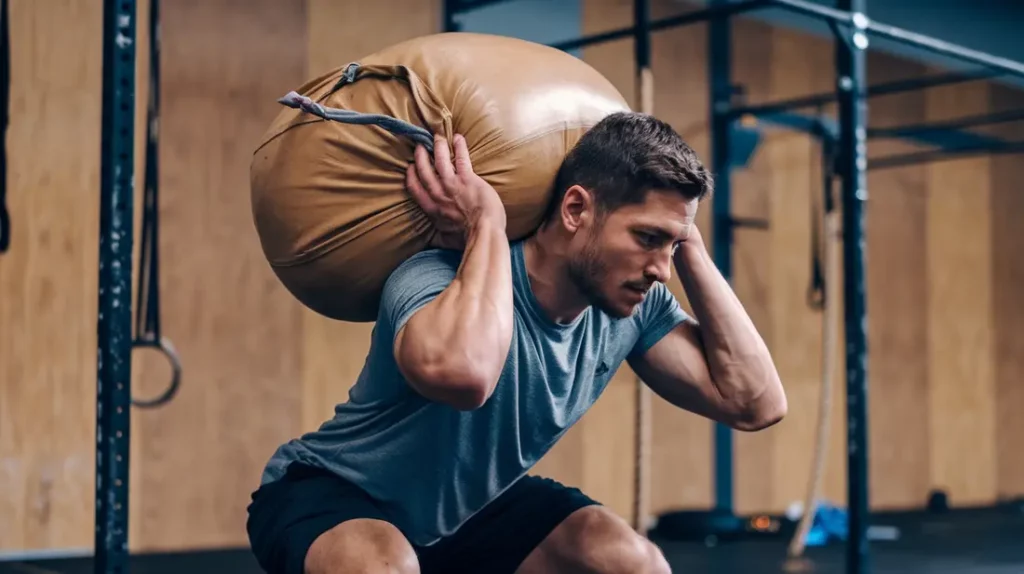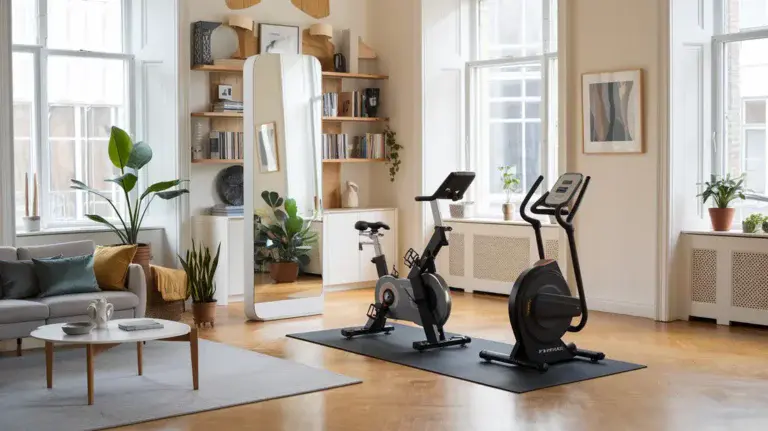Do you want to build a strong lower body that provides the foundation for everyday activities and athletic performance?
Then you need to learn the power of the sandbag squat.

This is more than just a leg exercise; it is a versatile and effective tool for building functional strength, core stability, and explosive power in your lower body, and it is essential for overall fitness.
With the sandbag squat exercise, you will be able to build strength in your legs, core and back, all at the same time.
This guide will show you how to perform the sandbag squat correctly, and you will also learn about the many benefits of this exercise, as well as different variations that will challenge you and help you to get maximum results from your workouts.
Understanding the Benefits of Sandbag Squats
The sandbag squat exercise is more than just a lower body exercise; it’s a gateway to unlocking overall strength, stability, and fitness.
Here’s how this versatile movement can benefit you:

Full Body Engagement
- Core, Back and Legs: While the sandbag squat exercise is primarily known as a lower body exercise, it also engages the core, back, and legs all at the same time.
- Muscle Coordination: This requires your entire body to work together in a coordinated way, making it a very effective full body workout, that will build strength in all of your major muscle groups.
Lower Body Strength
- Key Muscle Activation: Sandbag squats effectively target your quadriceps, hamstrings, and glutes, all of which are essential for building lower body strength, power, and stability.
- Power and Endurance: By using a heavier weight you can work on building strength and power in your legs, and with lighter weights you can improve muscular endurance.
Core Stability
- Unstable Load: The unstable load of the sandbag forces your core muscles to work harder, and engage more, to maintain your balance, and to stabilize the spine throughout the exercise.
- Improved Control: This will help to improve core stability, which will ultimately improve balance, and control in all other exercises, and in your daily life.
Functional Movement
- Real World Relevance: Sandbag squats train your body to move in a functional way that mimics real-world movements, such as lifting, carrying or bending.
- Everyday Activities: This translates into improved ease and efficiency in everyday tasks, such as climbing stairs, lifting objects, and performing your day-to-day activities.
- Improved Coordination: This will also help to improve your coordination, and allow you to move more easily.
Calorie Burning
- Cardio Component: Sandbag squats can have a cardiovascular impact, and burn a lot of calories, especially when they are done using higher repetitions, and with minimal rest periods.
- Increased Fitness: By using a sandbag, your heart rate will increase, and you will also be building muscle, which means that you will also be improving your overall fitness, and burning calories.
Mastering the Sandbag Squat Technique
To maximize the effectiveness of the sandbag squat exercise and to avoid injuries, it’s essential to perform the exercise correctly.
Here’s a breakdown of the proper technique, common mistakes to avoid, and how to modify the exercise to suit your needs:

Step-by-Step Instructions
- Starting Position: Stand with your feet shoulder-width apart, with the sandbag held in front of your chest (goblet squat), across your upper back (back squat), or in front of your chest with your elbows bent (front squat).
- Engage Your Core: Before you begin the squat, engage your core muscles, by tightening your stomach muscles, and drawing your belly button towards your spine.
- Squat Down: Push your hips back, and bend your knees, while keeping your back straight. You must imagine that you are sitting back into a chair.
- Go as low as you can: Only go down as low as you are comfortable, and if you are new to training, then you can start with partial squats. The ideal depth is when your thighs are parallel to the floor.
- Maintain a Straight Back: Throughout the squat movement, ensure that your back is straight, and your core is tight. Do not round your back.
- Push Through Your Heels: Push through your heels to return to the standing position, engaging your glutes, and using your leg muscles, to generate the power. You should always move through the range of motion in a slow and controlled manner.
- Engage Glutes: At the top of the movement, engage your glutes, by squeezing them tightly. This is a great way to engage your leg and glute muscles.
- Repeat: Repeat this movement for the desired number of repetitions, and continue to focus on maintaining proper form, and a controlled movement.
Proper Form
- Back Alignment: Keep your back straight during the movement. You must avoid rounding your back as this will put pressure on your lower back.
- Engage Your Core: Ensure that your core muscles are engaged throughout the exercise, by tightening your abs and drawing your belly button in towards your spine.
- Controlled Movement: Use slow, and controlled movements, and try not to use momentum. You must be able to perform the exercises with good form, to prevent injury, and to maximize the benefits.
- Foot Placement: Keep your feet flat on the ground throughout the movement, and make sure that your knees do not go past your toes.
- Full Range of Motion: You should try to work through a full range of motion, but always start with a range of motion that you can comfortably manage. If you feel pain during the exercise, you must stop immediately, and try to reduce the intensity of the movements.
Common Mistakes to Avoid
- Rounding your Back: Rounding your back is a very common mistake, and can cause lower back pain. It is vital to make sure that you are keeping your back straight during the movement.
- Using Momentum: Avoid using momentum, and focus on using your muscles to perform the exercise in a slow and controlled manner.
- Knees Past Toes: Do not let your knees go past your toes. This will put pressure on the knee joint, and will lead to injuries.
- Partial Movements: Only performing partial movements, will limit the effectiveness of the exercise. You should always aim to perform the exercise through the full range of motion, if possible. You can also start with body weight exercises before you move on to using the sandbag.
- Using Too Much Weight: Using too much weight, can also lead to poor form, and increases the risk of injury. You must always be able to perform the exercise using good technique, before you increase the weight, and the intensity.
- Ignoring Pain: If you are feeling any pain during the exercise, then you must stop immediately, and listen to your body.
Modifications
- Goblet Squat: You can perform a goblet squat, by holding the sandbag at your chest. This will help you to improve your core strength, and stability.
- Partial Squat: If you are new to training, you can do a partial squat, and focus on working through a smaller range of motion, and focusing on your core, and balance.
- Wall Squat: You can perform a wall squat by placing your back against a wall, and sliding down into a squat position. This will allow you to focus on correct technique, and it will also provide additional support for your back.
- Vary the Weight: You can vary the weight that you are using to suit your needs.
Sandbag Squat Variations for Maximum Impact
While the basic sandbag squat is a great exercise, incorporating variations will help you to challenge your muscles, and to progress to new levels of strength, stability and fitness.
This section will explain a range of different variations, including the instructions, benefits, and how they are different from each other:
Sandbag Front Squat

- Instructions: Hold the sandbag in front of your chest, with your elbows pointing down towards the floor, and your core engaged. Squat down, keeping your back straight, and your chest up. Push through your heels to return to the starting position.
- Benefits: This variation puts a greater emphasis on your quads, and will also improve your core strength. This is a great exercise to improve overall stability and balance.
- Core Engagement: The front loaded weight of the sandbag, will also force your core muscles to work harder, to maintain stability.
Sandbag Back Squat

- Instructions: Place the sandbag on your upper back, supporting it with your hands. Stand with your feet shoulder width apart, and perform a squat, whilst keeping your back straight, and core engaged.
- Benefits: This exercise is ideal for building strength in your glutes and hamstrings, which are essential for powerful movements. The sandbag is also more comfortable to carry on your upper back, which means you can often use a heavier weight.
- Target Different Muscles: This will also allow you to target the lower back and glutes more effectively, and will build a different type of strength compared to the sandbag front squat.
Sandbag Goblet Squat
- Instructions: Hold the sandbag at your chest, with your hands cupping the sides of the sandbag. You will then perform a squat, whilst holding the sandbag in that position. Focus on keeping your back straight, and engaging your core muscles during the movement.
- Benefits: The goblet squat is a great variation for building core strength, stability and balance, which is very beneficial for everyday activities, and for improving your athletic performance.
- This will also help to improve your posture, and core stability.
- Easy to Learn: This type of squat is also very easy to learn, which makes it ideal for beginners.
Sandbag Zercher Squat
- Instructions: Hold the sandbag in the crook of your elbows, and perform a squat. You should engage your core, and keep your back straight during the movement.
- Benefits: The Zercher squat is a more advanced variation of the sandbag squat, which is a great way to improve your core strength, and your back muscles. It also requires greater full body engagement, which builds functional strength, and improves your core stability.
- Core Stability: This carry places a greater emphasis on your core muscles, which makes it a great exercise for building core strength.
- You will also find that it is very beneficial for improving posture.
Progression
- Master the Basics: It is important to ensure that you have mastered the standard sandbag squat, before you move on to any other variations.
- Gradual Progression: You must only progress when you feel that you are ready, and you are comfortable performing the basic exercises correctly. You must not move on to more advanced variations, if you are still struggling with the basics.
- Listen to Your Body: If you feel any pain during an exercise, then you must stop immediately, and you must also focus on maintaining proper form at all times. You can vary the weight and the intensity as you get stronger.
Differences Between the Squat Variations
- Sandbag Front Squat: Emphasizes quads and core. Sandbag held in front of chest, and will force you to keep your back straight.
- Sandbag Back Squat: Targets glutes and hamstrings, as well as the lower back. It is also a great exercise to use when trying to move more weight.
- Sandbag Goblet Squat: Focuses on core stability and is good for learning proper squat mechanics, due to the positioning of the sandbag.
- Sandbag Zercher Squat: This exercise is a more advanced variation, and challenges core stability, upper back, and biceps, as well as the legs.
Integrating Sandbag Squats Into Your Workout Routine
The sandbag squat is a versatile exercise that can be incorporated into a range of different workout routines, depending on your goals.
Here are some specific ideas on how to effectively integrate them into your training:
Workout Routine Ideas
- For Strength:
- Focus on Lower Reps, Heavier Weight: Use a heavier weight, and perform a lower number of repetitions (e.g. 3-5 reps), with a greater emphasis on the quality of movement, proper form, and explosive power.
- Combine with other exercises: Incorporate the sandbag squat exercise into other strength exercises, such as deadlifts and rows, to build a full body strength routine.
- For Endurance:
- Higher Repetitions: Use a lighter weight, and perform a higher number of repetitions (10-15 reps), with minimal rest periods, to improve muscular endurance and fatigue resistance. You can also focus on the speed of the movement, and try to do it as fast as possible, while also maintaining a controlled movement.
- Time-Based Intervals: You can try performing sandbag squats for a set amount of time, such as 60 seconds, and then resting. Repeat this for several sets.
- For Cardio:
- Burpee Variation: Combine sandbag squats with other cardio exercises, such as burpees, to increase the heart rate and burn more calories.
- Circuit Training: Create a circuit training routine using sandbag squats, and combine this with other high intensity exercises, to create an effective workout plan.
Workout Frequency
- Begin Slowly: If you are new to sandbag squats, then start with 2 sessions per week, with rest days in between. This will help to prevent injury, and allow your muscles to recover.
- Gradual Progression: As your fitness improves, you can gradually increase the frequency to 3-4 times per week, ensuring you are still getting sufficient rest.
- Listen to Your Body: Always listen to your body, and adjust your training schedule based on how you are feeling. If you are feeling tired or sore, you must take a rest day.
Rest and Recovery
- Rest Days: Plan for adequate rest days between workouts, to allow your muscles to repair and recover. You must prioritize rest, if you want to see improvements in your performance.
- Sleep: You must ensure you are getting adequate sleep each night (at least 8 hours), to allow your body to fully recover.
- Nutrition and Hydration: You should also be focused on a balanced diet, and ensuring that you are hydrated.
- Active Recovery: When you are not doing the sandbag squats, you can perform light activities such as stretching, yoga or walking, to improve circulation and speed up the recovery process.
Choosing the Right Sandbag for Squats
Choosing the right sandbag is very important for ensuring that you can perform the sandbag squat exercise correctly, and that you are also able to progress and challenge yourself.
Here are some key considerations to keep in mind when choosing a sandbag:
Weight Recommendations
- Beginner: If you are new to sandbag training, start with a lighter sandbag (10-20 lbs) to focus on proper form and technique, and to make sure that you can maintain a controlled movement throughout the exercise.
- Intermediate: As you get stronger, you can use a medium-weight sandbag (20-40 lbs) to start challenging your body further. This will help you to build more strength and to increase the intensity of your workouts.
- Advanced: If you are advanced, then you can use heavier weights (40 lbs or more) to maximize your gains, but this will require greater stability, and core strength, and you must make sure to maintain good form.
- Adjustable: Opt for an adjustable sandbag so you can easily change the weight to match your current ability, and to suit the exercise that you are doing. The ability to adjust the weight, will also help to maximize your progression.
Size and Material
- Compact: Choose a sandbag that is not too bulky and that feels comfortable to hold. A medium sized, cylindrical sandbag is a great option for performing sandbag squats.
- Durable: Use a durable material that can withstand the weight, and the movement required for squats, such as nylon, or reinforced canvas.
- Easy to Clean: It is also useful if the material is easy to clean, as you will be using it for a variety of exercises, in different places.
Handle Design
- Multiple Handles: You should look for a sandbag that has multiple handles that are placed on the side and ends. This allows for versatility, and also gives you multiple options for performing different types of sandbag squats.
- Comfort and Grip: The handles should be easy and comfortable to grip, and they should be made of a material that does not slip easily. They should also be attached to the bag securely.
DIY Options
- Duffel Bag: A duffel bag is a good option if you are looking for a low cost, and effective sandbag, and you can easily fill the duffel bag with sand, and use this for your workouts.
- Heavy-Duty Bag: A heavy-duty bag with a zipper can also be used for sandbag training, and will provide an inexpensive option for you. You can also fill the bag with sand, and close the zip.
- Inner Liners: If you are making a DIY sandbag, make sure to use some inner liners such as plastic bags or waterproof bags, to keep the sand contained, and to avoid any leakage. This will also increase the durability of your sandbag.
Key Takeaways
- Focus on Your Ability: You must always select a weight that is suitable for your fitness level.
- Durability: Ensure that the sandbag that you purchase, is durable and made of a strong material.
- Comfort: Ensure that you choose a sandbag that is comfortable for you to hold.
- Budget: It is also important to choose a sandbag that fits your budget, and do not spend money on expensive equipment if you are looking for a low cost way to train.
FAQ (Frequently Asked Questions)
Here are some common questions and clear answers about the sandbag squat exercise:
Is the sandbag squat better than barbell squats?
- Both exercises are effective, but they offer different benefits.
- Barbell squats are better for building maximal strength, and will allow you to perform a high number of squats using a very heavy weight.
- Sandbag squats engage your core and stabilizing muscles more intensely, and provide a more functional type of strength that is more easily transferable to everyday activities, and real world scenarios.
- The type of squat that you choose depends on your fitness goals, and also your preferences.
What is the best way to do a sandbag squat?
- Proper Form: The most important factor to consider, is your technique. You must always focus on your form, to ensure that you are not injuring yourself, and also to get maximum benefit from the exercises.
- Controlled Movement: You must perform the exercise in a slow and controlled manner, and engage all your muscles during the exercise.
- Listen to Your Body: You must also listen to your body, and only go down as far as you are comfortable with.
How to do sandbag squats for glute activation?
- Squat Depth: To target your glutes more effectively, you should try to squat down to a depth, where your thighs are parallel to the floor.
- Push Through Heels: Make sure to push through your heels as you stand back up, to engage your glutes effectively.
- Engage the Glutes: You should also focus on engaging your glutes at the top of the exercise, by squeezing them tightly.
Can I do sandbag squats if I have lower back pain?
- You should always consult with a healthcare professional, before starting any new workout plan, especially if you are experiencing back pain.
- When performing the exercises, you must ensure that you are maintaining good form. Keep your core engaged, and your back straight throughout the exercise.
- Start with a lighter weight, and focus on mastering the basic movements, before you try more difficult variations.
- If you feel any pain in your lower back, you must stop the exercises immediately, and take rest.
Are sandbag squats suitable for beginners?
- Yes, sandbag squats are suitable for beginners if you start slowly and use a lighter weight.
- You must always make sure to focus on mastering the proper technique, and that your movements are slow and controlled. You can also start with partial squats if you are new to training.
Conclusion – Transform Your Lower Body with Sandbag Squats
You now have a full guide on how to master the sandbag squat exercise, and you have a detailed understanding of the benefits and the different techniques involved in this effective, and versatile exercise.
It’s time to stop just thinking about getting stronger legs, and to take action to build the lower body strength that you deserve.
Here’s a quick recap of the key benefits that you’ll experience with sandbag squats:
- Full Body Engagement: By performing the sandbag squat exercise you will strengthen your legs, core and back, which are the major muscle groups that are key for most movements.
- Lower Body Strength: You will build a strong foundation of lower body strength, which will improve your performance in everyday activities, and in sports.
- Core Stability: You will also build a strong core, which will help to stabilize your body during all exercises.
- Functional Fitness: You will improve your functional fitness, as this exercise will help you to maintain a good posture, and move correctly.
- Improved Calorie Burn: You will improve your overall fitness, whilst also burning calories and fat.
It’s time to take control of your fitness, and to build the lower body that you have always wanted.
Incorporate sandbag squats into your routine, and unlock your full potential.
Start slowly and focus on mastering the correct technique, and then you can progress to more advanced variations as you get stronger.
Are you ready to transform your lower body with the power of sandbag squats?
References
- Chandramouli Krishnan, Eric J Allen, Glenn N Williams. Effect of knee position on quadriceps and hamstring EMG during a squat exercise. Journal of Strength and Conditioning Research, 17(4), 684-690.
- Behm, D. G., Leonard, A. M., Young, W. B., Bonsey, J., & McNaughton, L. R. (2010). Trunk muscle electromyographic activity with unstable and unilateral exercises. Journal of Strength and Conditioning Research, 24(9), 2486–2495.



